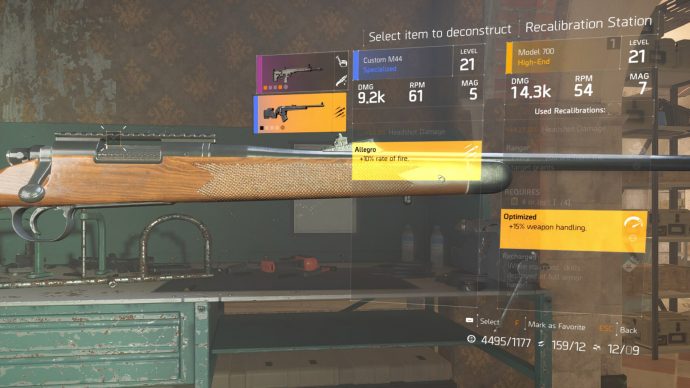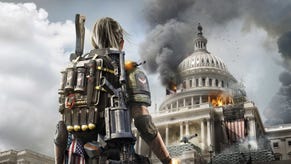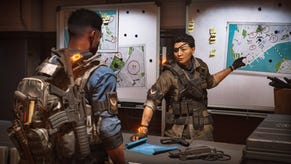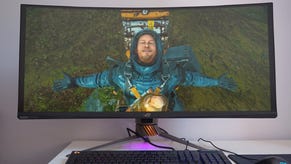The Division 2 Recalibration guide - how to transfer stats and talents, Recalibration explained
Reduce, Reuse, Recalibrate
Plenty of systems in The Division 2 have been rethought and refined from its first iteration in The Division 1, and prime among them is the redesigned Recalibration Station. This station is unlocked through Staff member Emma Richards, and can be used to transfer attributes and talents from one item or piece of gear to another. It's also a pretty confusing station to get to grips with at first, which is why our The Division 2 Recalibration guide will walk you through how to use this area of your Base of Operations to upgrade both your items and your Gear Score while you're at it.
If you're after a more general overview on Tom Clancy's latest open-world loot-and-shooter, check out our main The Division 2 guide, which is packed with beginner's tips and links to our sections of our guides series, from stats and explanations of the different The Division 2 weapons/guns to all The Division 2 best builds, and much more.
The Division 2 Recalibration guide - using the Recalibration Station
In simple terms, Recalibration in The Division 2 is a way of improving your equipment. There are various ways to do this, of course: attaching mods springs to mind, as well as simply going out and finding better quality items across the streets of Washington D.C. - but Recalibration offers a way for you to transfer across certain aspects of one item to another item of the same type.
First we'll walk you through what you'll need to do to unlock the Recalibration Station if you don't yet have it; then we'll dive into exactly how to use the Station to transfer talents and attributes, and upgrade your equipment.
How to unlock the Recalibration Station (Emma Richards)
To unlock the Recalibration Station, as with all other aspects of your Base of Operations that aren't accessible at the beginning of the game, you'll need to recruit a specific Staff member. For more information on all of these individuals and what they unlock, check out Dave's The Division 2 staff guide; but for now, you'll need to track down Emma Richards to unlock Recalibration for your agent.
Emma Richards becomes available to talk to the moment you complete three of the main missions that are unlocked after you enter the Campus settlement (found in the Downtown West area of your map). Once you have completed your third out of these missions, you'll receive a notification on your map to recruit Emma Richards at the Campus.
Emma can be found right in the entrance of the Campus settlement, just before the space opens up into the main Campus area. Once you've spoken with her, you can find her again in your Base of Operations in The White House, right next to the Crafting Station. Simply walk into the Base, take a left, and she'll be on your left-hand side - standing behind your brand new ready-to-use Recalibration Station.
Transfer Attributes and Talents using the Recalibration Station
Recalibrating items in The Division 2 throws everyone for a loop at first, but that's mainly due to the little limitations and quirks that we'll get to in just a moment. In actuality, the whole process is very straightforward.
Recalibration is used for transferring across two things: talents, and attributes:
- Talents are the special traits that come with higher-quality weapons and gear: for example, you might have a pair of gloves with the Devastating Talent, which increases your weapon damage by +5%.
- Attributes are small value-based benefits such as "+X Critical Hit Chance", or "+X Health on Kill". They will either have a red, blue, or yellow icon next to them - this is important for Recalibration, as you'll find out below.
Recalibrating an item will cost you money, as well as certain resources. To recalibrate a weapon, for example, you'll need a certain amount of Steel and Titanium in addition to the base cost of the process. It's also worth noting that if you've hit Level 30 and you're into Gear Score territory, then you can use the Recalibration to better your Gear Score by improving certain Attributes to an upgraded version of themselves.
How to use The Division 2's Recalibration Station
To Recalibrate an item, first select the item that you want to recalibrate, and then select the Talent or Attribute that you would like to replace - if you like, you can think of it as "re-rolling" that Attribute/Talent for a different one. Once you've done this, you will be presented with a list of all viable replacements that the game has found in your Inventory. Select your replacement trait that you'd like to be transferred to the item you first selected, and then confirm your choice to Recalibrate.
The second item you chose will be destroyed in this process, but its Talent/Attribute that you chose will be brought over to replace the selected Talent/Attribute from the first item.
In this manner, you can upgrade your gear in very specific ways of your choosing, in order to put together powerful synergistic builds where all your equipment works together around a single goal or playstyle. For more info on some of the very best builds that you can put together in the game currently, check out our The Division 2 best builds guide.
Limitations to Recalibration in The Division 2
Now let's go over some of the limitations of the Recalibration Station in The Division 2, because this is what tends to confuse people when they're trying out this system for the first time. There's an awful lot of "wait, why can't I do this?" or "how come that happened?" going on if you aren't aware of the following caveats.
- Once you've Recalibrated an item, you can never again use Recalibration on a different aspect of that same item. If you transfer a Talent onto a certain weapon, then you cannot use the Recalibration Station on that weapon again unless it's to change that same Talent. Same goes for Recalibrating a specific Attribute - once you've done it, you can't touch any other Attributes or Talents on that item apart from the one you added.
- You cannot add more Talents or Attributes than your item can hold. In order to transfer across a specific aspect of an item, you need to replace an existing aspect of the same type. So if you want to add that Killer Talent, you'll need to replace that Sadist Talent you already have.
- You cannot Recalibrate crafted items. For whatever reason (probably a good one), the devs have made the choice that you are unable to use the Recalibration Station on crafted items, only ones you have looted from across D.C.
- You can only Recalibrate items using the same type of item. This one makes sense when you consider that there are certain Talents and traits that can only be found for Shotguns, or Assault Rifles, and you obviously can't transfer them across. You have no choice when using the Recalibration Station but to use two of the same type of item for every transaction - so AR + AR, Rifle + Rifle, Gloves + Gloves, etc.
- When transferring Attributes, you can only replace an Attribute with another of the same type (same icon). This is where that icon next to an Attribute becomes more than just a measure of your type of build. If you want to replace an Attribute with a red icon, you can only replace it with another red icon Attribute. Same with blue Attributes, and yellow.
- Pay attention if a process says "Capped to X%". Sometimes when transferring/upgrading certain Attributes, the value of that Attribute will be capped at a certain point which is less than the value that it currently has. In the screenshot above, for example, you'll see that the "+9% Assault Rifle Damage" Attribute that the player is attempting to transfer across will be capped at "+4%" instead. Be aware of this "Capped to X%" text when it appears, to save yourself from disappointment and give yourself a chance to back out if it's not something you want to do.
And that's all you really need to know regarding Recalibration in The Division 2. Hopefully this gives you an idea of how you can use Emma Richards' Recalibration Station to better your equipment and your Gear Score. Now, then; better start improving your equipment, agent.









